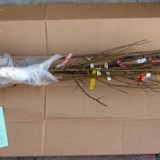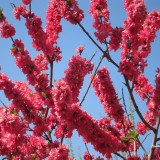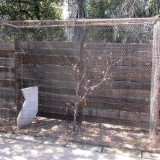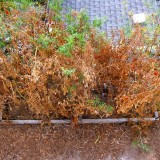
This morning Kelly alerted me to the latest avocado news making its way around the internet tubes. Apparently a chain of grocery stores in Great Britain, worried about the lack of knife skills in our young folks (ugh), is marketing a seedless “cocktail” avocado.
What is a cocktail avocado? Some deep Googling revealed that they aren’t some new variety, just un- or under pollinated Fuerte avocado. Since we have a Fuerte tree in our backyard, I decided to do a deeper form of Googling, which involved prying myself away from the internet tubes and going outside for some first hand investigation. Ka-ching! I found a cocktail avocado that I plan on selling to a knife challenged Brit for a high and undisclosed price.
So how do cocktail avocados happen? Avocado pollination is one of the more complicated mysteries of nature for which I will turn to UC Davis for an explanation,
The first or female stage remains open for only 2 or 3 hours. The flower then closes and remains closed the rest of the day and that night. The following day it opens again. But now the stigma will no longer receive pollen. Instead, the flower is now shedding pollen. That is, each flower is female at its first opening, male at its second. After being open several hours the second day, the flower closes again, this time for good. If it had been successfully pollinated at the first opening, and if other conditions are right, it will develop into a delicious fruit.
People mistakenly think that avocados trees are either male or female. In fact, they are all both. The differences between trees are about when the timing of this alternate gendered flowering occurs. UC Davis goes on to explain,
Nature has provided for avocado cross-pollination by creating varieties of two kinds. The “A” type is female in the morning of the first day and male in the afternoon of the second day (when the weather is warm). The “B” type is just the reverse: its flowers are female in the afternoon and male the following morning.
The fact that we have two hives of honeybees in our backyard and lots of other avocado trees in the neighborhood means that we don’t get a lot of cocktail avocados. I could not find any information about the methods of cocktail avocado growers (located in Spain). I suspect they are either using nets to exclude bees or they are just selectively harvesting the cocktail avocados that naturally occur on every tree.
Support Root Simple
The New Sugar & Spice: A Recipe for Bolder Baking. A 2016 James Beard Award nominee featuring more than eighty recipes from New York-based food writer and author of the popular dessert blog Love, Cake.






We bought some from a roadside stall in rural Australia and have been wondering about it ever since. Thanks for solving the mystery 😉
So, my dad tells me there are A, B and C, types of avocado trees. A needs a B type to be pollinated, and the B type needs a C type for pollination. The theory is, our avocado *used* to make fruit many decades ago until a neighbor cut down their avocado tree. Since then, nothing at all. But the tree on the other side of our tree, produces gangbusters of fruit. So the theory is our prolific neighbor tree is an A, ours is a B, and the gone tree was a C. Does this have any merit, perhaps along the lines of there are no trees producing male pollen when our tree has female blooms open, and our tree ‘goes male’ when the neighbor’s tree is blooming? Fascinating stuff.
Wups, jumped the gun on my response, and just re-read that ‘A’ and ‘B’ paragraph. So that just confirms our theory (perhaps without the ‘C’) tree. Odd thing is we have so many avocado trees in our neighborhood, certainly some of them should be compatible with our tree, yet not. I wonder what the pollen range is? You’d think the pollinators wouldn’t have any problems, and there are no shortage of blooms on our tree. Our neighborhood is one of the old 1940s ones, where each lot is maybe an 1/8th of an acre, and most with a very mature avocado tree or orange tree in West Los Angeles.
You lucky ducks. Fuerte avocados are my favorite. Yum.
Yeah, they are delicious.
How is it possible so many cut themselves so badly when cutting an avocado, yet apples and pears are cut more often yet there is no such injury as to be named. Could it be avocado are preschool or drunk. Do not give knives and avocadoes to children.
I think it’s the big pit and the popularity of avocado toast.
My aunt had a large Haas tree which gave us delicious fruit every year. Then one year it produced these fingerling sized ones, which we were shocked to find were edible. Never saw them again til now!
There’s a great Jens Leckman song about a guy cutting himself while cutting an avocado, “Your Arms Around Me”: https://youtu.be/NIwIAbcLFhI
It’s totally a thing.
I can see this being the next big thing in L.A. Thanks for helping prevent “Avocado hand.”